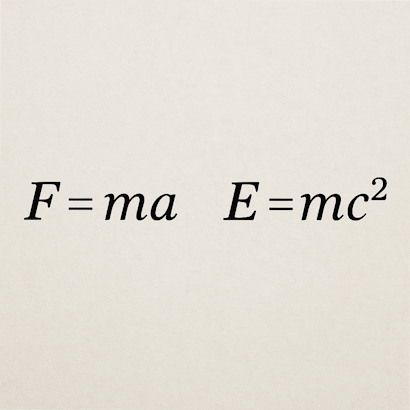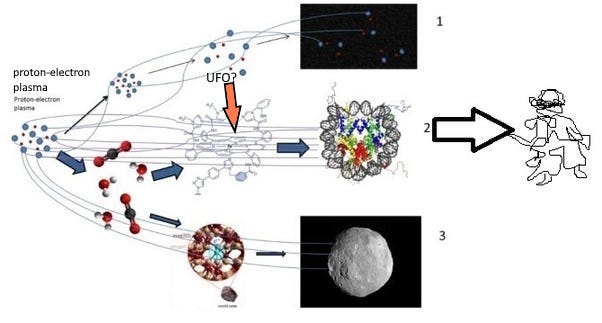
In the story of modern physics, Newton and Einstein stand like two great sentinels at the edge of human understanding. Yet their methods could not be more different. Newton peered into the cosmos through the lens of observation, building his laws from external motion and mechanical regularity. Einstein, by contrast, turned inward. His most profound discoveries came not from watching the skies but from imagining what it would be like to ride alongside light itself. Observation gave us classical mechanics; imagination opened the door to relativity. These two minds, in their distinct approaches, reflect the evolution of cognition itself — from mapping the outer world to uncovering the structures already living within.
There is a profound beauty in the journey from Newton to Einstein, not only in what they uncovered about the universe but in how they used their minds to do so. Newton perceived the universe as a grand machine. He saw motion, force, and matter interacting according to precise, measurable laws. His was a world of objects and consequences, where cause and effect were the dominant mode of understanding. The mind, in Newton’s framework, was a tool to map these mechanical motions — to detect patterns and apply them predictably. His laws gave birth to classical physics, a structure so solid that it held for centuries. His insight crystallised in the equation F = ma, revealing that force is not a mysterious quality but a measurable product of mass and acceleration — a precise tool for predicting how objects behave under influence. Newton used observation.
But Einstein’s mind moved differently. He did not begin with objects but with possibilities. He imagined chasing a beam of light and asked what the world would look like. In doing so, he shifted from observing reality to reconstructing it within his mind. This shift marked a deep turning point — not just in physics, but in the evolution of human cognition. Einstein trusted abstraction. He let go of the fixed backdrop of space and time and allowed them to bend and merge, to become participants rather than scenery. From that inner journey emerged E = mc², a deceptively simple equation that revealed energy and mass as two sides of the same coin — bound by the speed of light squared, the hidden geometry of spacetime embedded in the relationship. What’s striking is that this equation didn’t come from external instruments or laboratory data — it unfolded within Einstein’s own inner space. His visualisation of riding a light beam shows how the universe resides within us, how the mind, when properly attuned, becomes a reflective field of cosmic law. The equation emerged not as an abstraction imposed on reality, but as a truth discovered within the structure of his own cognition. The boundary between inner and outer dissolved, revealing that the universe was always within reach — within him. Einstein used Imagination.
What he discovered was not merely a new physical truth but a reflection of how the universe communicates with a different kind of mind — a mind attuned to structure over substance, to fields over forms. Where Newton saw laws governing motion, Einstein saw the fabric itself as law. Time and space were not passive arenas but part of the dynamism of existence. Mass and energy were not separate; they were two expressions of the same thing.
This is more than a historical moment. It is a clue. It tells us that the universe offers itself in layers, and the deeper we go, the more our mode of perception must evolve. The abstract is not an escape from the real — it is a deeper intimacy with it. Einstein’s mind was not simply brilliant. It was tuned to a subtler resonance of the cosmos, where relationships define being and where intuition dances with geometry.
To see this is to realise that our own cognition may still be unfolding, that insight is not the end but the threshold. If Einstein’s mind could glimpse spacetime by turning inward, then perhaps the next evolution of mind lies in learning to stabilise that inward gaze — not as escape, but as exploration. The future of cognition may not be in inventing new tools, but in learning to use the brain-mind as an instrument of resonance, capable of detecting the subtleties of cosmic structure as directly as Einstein did. Rather than solely manipulating matter, this next cognition might attune to patterns, to the living logic that underlies emergence. It may be that consciousness itself is the next field to be unified — not through equations alone, but by realising that the observer is the field in motion. The laws of nature are not only out there. They are also in here, awaiting the moment when a mind lets go of the known and touches the shape of what is yet to be understood. In this light, Einstein’s cognitive journey becomes even more revealing. His act of visualising light and bending space was not simply theoretical — it was the mind turning back on itself, doubling toward its own origin. As seen in layered models of emergence, from subatomic plasma to molecular and planetary forms, the same pattern reappears: consciousness reaching inward meets the structure of the cosmos. What emerged in Einstein’s equation came not from deduction alone, but from the reflection of the universe within his own mind-space. This recursive gesture — of the brain folding back to source — is perhaps the signature of higher cognition. It marks the moment when knowing and being, inner and outer, become one seamless field of awareness.
Postscript:
If there are beings in the universe that come closer to this source field — those who have evolved not just biologically but cognitively through resonance with the foundational layers of reality — then they may well be what Einstein could only intuit. Perhaps what we call UFO encounters are moments where such beings, formed from or through these deeper fields, enter our perceptual space. My own experience with such an encounter makes this possibility feel less like speculation and more like recognition. These beings, if truly near the source, may not be permanently fixed in form but able to shift between energetic states and the solidity we perceive. This could explain why they sometimes appear as physical, embodied beings — they are not only visiting from elsewhere in the universe, but from elsewhere in its very structure. They can be us, or appear as us, because their form arises from a fabric that is already folded into the cognitive and energetic space we inhabit. In this way, the equation that unfolded in Einstein’s mind was not only a physical revelation but an echo of a deeper reality shared across consciousness, matter, and what lies between.
This idea — that beings closer to the source may appear as solid when necessary — finds resonance across multiple fields. In physics, mass and energy are fluid states of the same phenomenon. In consciousness studies, perception is shaped by the frequency of awareness. And in mystical traditions, reality is layered, with higher beings able to traverse or condense into lower dimensions. Therefore, what Einstein glimpsed with abstraction, such beings may live as direct expression. Their form may be optional, a function of intention and context. The solid being, then, is not their truth — but their interface. And perhaps, as our own cognition evolves, we too may learn to shift between these modes of being.
The following diagram illustrates how cognition may evolve from Newtonian observation to Einsteinian introspection, tracing the recursive arc of the brain-mind back toward its source.

The following image complements this perspective by tracing how form and complexity emerge from the proton-electron plasma field, suggesting that intelligence — and perhaps even form — can arise from within the energetic structure of space itself.

While Einstein never spoke publicly of encounters with light beings or UFOs, his inner approach — so steeped in abstraction and intuitive visualisation — echoes the kind of cognition that such encounters might involve. As he once said, “The most beautiful thing we can experience is the mysterious. It is the source of all true art and science.” He also reminded us that, “The true sign of intelligence is not knowledge but imagination.” Though he never described such beings, his mind touched the fabric where such possibilities reside. In that light, his silence on the matter does not negate the resonance. It leaves the space open for the unfolding to continue.
